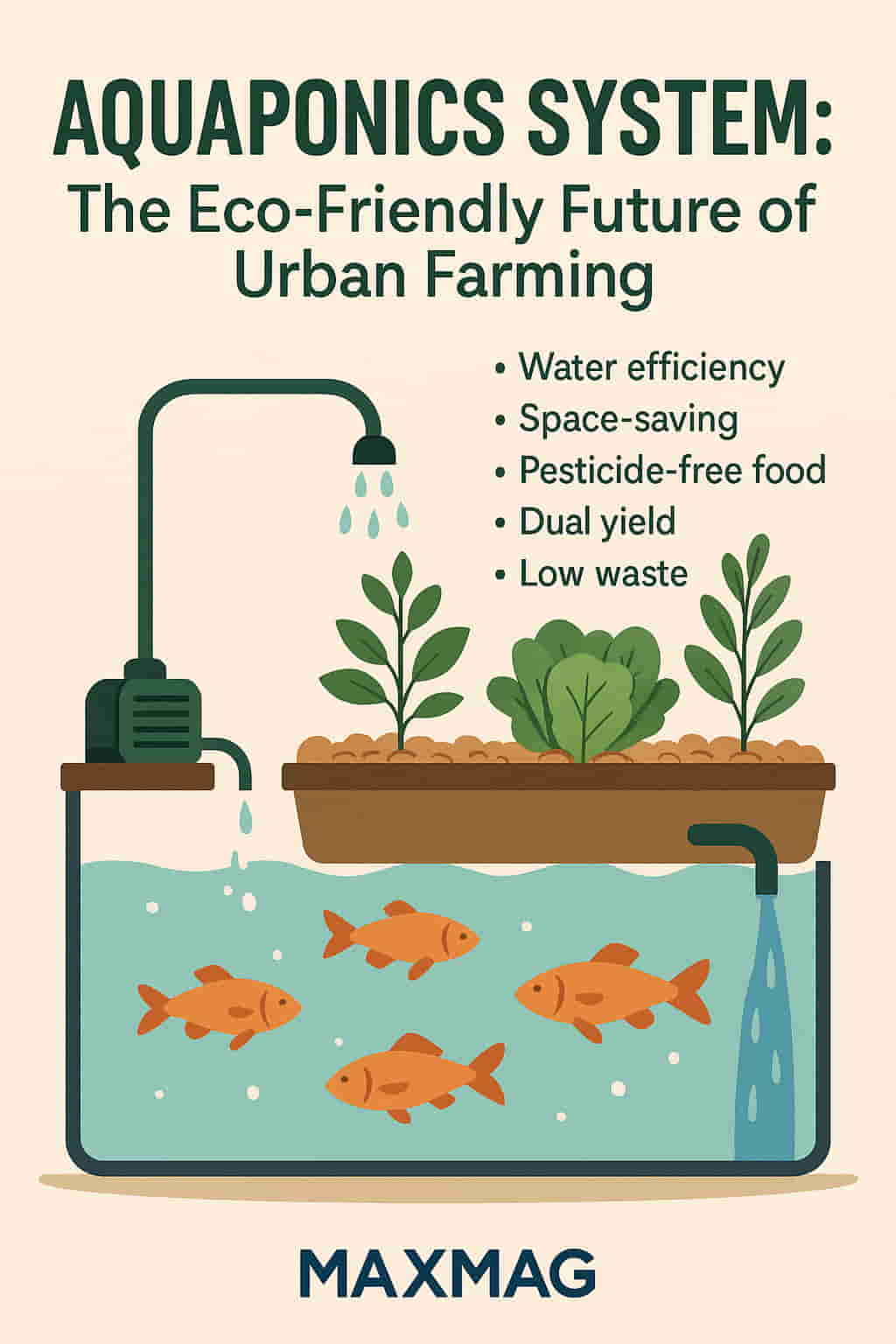
As cities grow and farmland shrinks, finding sustainable ways to produce food locally is more urgent than ever. One method that’s catching attention is the aquaponics system—a clever, symbiotic setup that lets you raise fish and grow plants together in a closed-loop environment. With more people looking to shrink their environmental footprint and grow healthy food in tight spaces, aquaponics offers a powerful solution.
In this article, we’ll explore how aquaponics systems work, why they’re ideal for home and urban use, what you need to build one, and how they can be scaled up for commercial farming. Whether you’re a hobbyist or a future food entrepreneur, this guide will walk you through the essentials of an aquaponics system and how to get started the right way.
What Is an Aquaponics System?
An aquaponics system is a combination of two farming techniques: aquaculture (raising fish) and hydroponics (growing plants without soil). The two are connected in a way that mimics nature: the waste produced by the fish provides nutrients for the plants, and in turn, the plants help clean the water, which is then recirculated back to the fish.
Think of it as a mini-ecosystem. Fish produce ammonia-rich waste, which is broken down by beneficial bacteria into nitrates. These nitrates are perfect plant food. Meanwhile, the plants absorb the nutrients, purifying the water before it flows back to the fish tank. The result is a system that conserves water, reduces waste, and produces two types of food—fish and vegetables—with minimal inputs.
This method isn’t just efficient; it’s also remarkably sustainable. According to the US Environmental Protection Agency (EPA), agricultural water usage is a major stressor on freshwater sources. Aquaponics systems can use up to 90% less water than traditional farming methods—without harmful runoff or synthetic fertilizers.
Why Choose an Aquaponics System?
There are several compelling reasons why more people are adopting aquaponics, particularly in cities and suburban areas.
-
Efficient water use: Water in an aquaponics system is reused continuously, making it ideal for areas facing drought or water restrictions.
-
No soil needed: Plants grow in a medium like clay pebbles or in water itself, so you don’t need access to land or fertile soil.
-
No chemical fertilizers: Nutrients are provided naturally by the fish, eliminating the need for added fertilizers.
-
Minimal space requirements: You can install a compact system on a balcony, patio, or even indoors with the right lighting.
-
Dual food production: You harvest both vegetables and fish, making your system more productive than most backyard gardens.
Moreover, aquaponics has been embraced by educational programs and community gardens. The USDA’s Urban Agriculture Toolkit even includes resources for schools and nonprofits to start their own systems.
How Does an Aquaponics System Work?
At the heart of an aquaponics system are three living components:
-
Fish – These are the nutrient producers. As they eat and grow, their waste fuels the rest of the system.
-
Plants – Positioned in grow beds, they absorb the nutrients from fish waste and purify the water.
-
Bacteria – Nitrifying bacteria are the invisible workhorses. They convert toxic ammonia into safe nitrates, completing the nutrient cycle.
Here’s a simplified version of the process:
-
Fish waste builds up in the tank.
-
Water is pumped to the grow bed, where bacteria convert ammonia to nitrates.
-
Plants take in the nitrates through their roots.
-
Cleaned water returns to the fish tank.
This continuous loop creates a low-maintenance, balanced system once established. With regular monitoring and occasional maintenance, an aquaponics system can run smoothly for years.
Getting Started: What You Need
Setting up a basic home aquaponics system doesn’t require advanced tools or a huge budget. Here’s what you’ll need:
Core Components
-
Fish tank – This holds the fish and is the source of nutrients. Start with 20–100 gallons depending on your space.
-
Grow bed – A container above or beside the tank that holds plants in a growing medium.
-
Water pump – This circulates water between the tank and the grow bed.
-
Grow media – Expanded clay pebbles are popular because they’re lightweight and provide good aeration.
-
Aerator or air pump – Keeps the water oxygen-rich for both fish and bacteria.
-
pH and water testing kit – To monitor system health and ensure balance.
If you want guidance with system designs, Colorado State University Extension offers helpful schematics and tips.
What Kind of Fish and Plants Should You Use?
Choosing compatible fish and plants is essential to keeping your system stable and productive.
Popular Fish for Aquaponics
-
Tilapia – Hardy, fast-growing, and tolerant of beginner mistakes.
-
Goldfish – Great for ornamental or non-edible systems.
-
Catfish – Bottom dwellers that adapt well to tank life.
-
Bluegill – Common in North America and good for edible systems.
Ideal Plants
-
Lettuce
-
Basil
-
Spinach
-
Swiss chard
-
Kale
-
Mint
-
Tomatoes (with larger systems)
These plants are nutrient-hungry and grow quickly in water-based systems. Herbs, leafy greens, and some fruits do especially well.
Designing for Your Space
One of the best things about aquaponics is how adaptable it is. You can scale your system to suit the space you have:
-
Indoor Units: Use a 20-30 gallon tank with LED grow lights and a small grow bed for herbs.
-
Balcony or Patio Systems: Use larger containers or IBC totes and solar-powered pumps for off-grid systems.
-
Backyard Setups: Build a larger greenhouse system with room for multiple beds and a larger fish population.
If you’re concerned about energy use, consider solar kits and insulated tanks to maintain temperature without costly heating.
For more eco-friendly ideas, see the National Renewable Energy Laboratory for guides on solar integration into home systems.
Maintenance and Monitoring
Once your system is up and running, it mostly takes care of itself—but some maintenance is essential:
-
Feed the fish daily (unless automated).
-
Check pH weekly (ideal range: 6.8–7.2).
-
Test ammonia and nitrate levels every few days during early cycling, then weekly.
-
Harvest plants regularly to encourage growth.
-
Clean the pump filters and inspect for blockages monthly.
You’ll also need to “cycle” the system for the first few weeks. This means letting bacteria establish and nutrient levels stabilize before adding too many fish or plants. Most systems become stable after 3–4 weeks.
Troubleshooting Common Problems
Every aquaponics system has learning curves. Here are a few common hiccups and how to avoid them:
-
Algae growth – Caused by light exposure to the fish tank. Cover it or use a shaded lid.
-
Fish stress – Usually from poor water quality. Regular testing and partial water changes help.
-
Plant yellowing – Indicates a lack of nutrients. Add more fish or use a natural iron supplement.
-
Clogged pipes – Prevent by adding pre-filters or flushing your grow beds occasionally.
Expanding Into Commercial Aquaponics
What starts as a hobby can grow into a full-fledged business. Larger systems, often set up in greenhouses, can produce hundreds of pounds of vegetables and fish annually. Some urban farms sell to local restaurants or operate community-supported agriculture (CSA) programs.
Organizations like AgriLife Extension at Texas A&M provide extensive business planning resources for commercial systems, including licensing and sustainability planning.
Scaling up means more automation—like dosing pumps, automatic feeders, and water quality sensors. These tools help maintain consistency, especially when growing for market.
The Environmental Impact
Aquaponics systems are an example of circular economy in action. They reduce:
-
Water waste
-
Fertilizer runoff
-
Transportation emissions (when grown locally)
-
Dependence on monoculture farms
The more decentralized food production becomes, the more resilient communities are in times of supply chain disruption, climate change, or economic downturn.
FAQ: Aquaponics System
Q1: How long does it take to get results?
Most systems begin producing edible greens in 4–6 weeks after setup. Fish take longer—3 to 6 months, depending on the species.
Q2: Is it expensive to maintain?
Once built, maintenance costs are low. Expect to spend on fish food, occasional plant supplements, and minimal electricity.
Q3: Can I use any type of fish?
It’s best to use species adapted to tank life. Tilapia, catfish, and goldfish are great starters.
Q4: How often do I change the water?
Rarely. In a healthy aquaponics system, water is reused indefinitely with only occasional topping up due to evaporation.
Q5: Can this work in cold climates?
Yes, with proper insulation or by setting up indoors with grow lights.
Q6: Do I need a greenhouse?
No, but greenhouses extend the growing season and protect against pests and weather changes.





